During the 60s and 70s football was a much more working class sport. For a start a minority of relatively well-off people actually sat down at a game. The stand was where decent, usually older men (and it was mostly men) could be shielded from the adolescent noisy ne’er-do-wells who populated the vast, gaping terraces. The only women who ever ventured to a football match were what would be later described as WAGs. The (current) girlfriends and the (current) wives. Until, of course their beaus were caught being indiscreet in a local night-spot with a girl called Sharon. Or Tracey. Footballers from this bygone era must look at the automatons and athletes playing for top clubs now and wonder if they are the same species. Apart from earning more money in a week than 60s or 70s players would earn in a career, modern players’ bodies are temples and not the temples of doom belonging to yesteryear stars. Today’s top players are rarely even photographed leaving nightclubs in a sheepish manner, their minders, advisers, gurus and agents warning them off such behaviour. Most, I would guess, aren’t even bothered about attending such emporiums of temptation. One couldn’t really imagine Kevin De Bruyne or Christian Erikson leaving Romeo and Juliet’s night spot in Bury or Hornchurch holding hands with Kylie, who had been out on a travel agents’ beano, who earlier had been knocking back Mojitos like they were going out of fashion. Now the same couldn’t be said for Stan Bowles or Frank Worthington or even, for that matter, Charlie Nicholas. It’s also well documented that footballers left training at lunchtime and headed straight for the boozer. Ten pints and 40 fags later they would drive home in their Ford Sunbeam and doze in front of Quizball until it was time for training again the next morning. Where did it all go sadly, and boringly, right for today’s footballers?
An insight into how 60s and 70s and players were from a very different planet completely can be found in the football publications of those, seemingly, far off days. Many publications came and went and some came across as just too boring to even recall (Charles Buchan’s Football Monthly?) but the two stalwarts of the genre were ‘Goal’ (1968) and ‘Shoot’(1969).
‘Goal’ was aimed at a slightly older target audience, 16+ while ‘Shoot’ was targeted at younger readers, around 10-15.
Shoot magazine was colourful, crammed with pictures and posters of current football stars and teams to be pinned up on a bedroom wall, whether you supported those teams or not. Shoot also did something that was, many years later, to be used very successfully by a plethora of ‘celebrity’ magazines. It not only shared intimate details of top footballers with its readers (nightclub liaisons notwithstanding) but also suggested that these lofty sporting individuals were our friends.
Shoot introduced a range of long-running features which not only attempted to get under the skins of these demi-gods, but took us into their gorgeous luxury homes (or ‘mansions’ as they liked to refer to them,) and shone light into the magic that was their impossibly glamorous lives (or so we were led to believe).
Shoot’s longest-running and USP feature was ‘Focus on…’ where a different footballer each week was given a series of questions about their likes, dislikes and petty peccadillos. It took a little time to realise just how limited and narrow footballers’ lives and attitudes actually were.
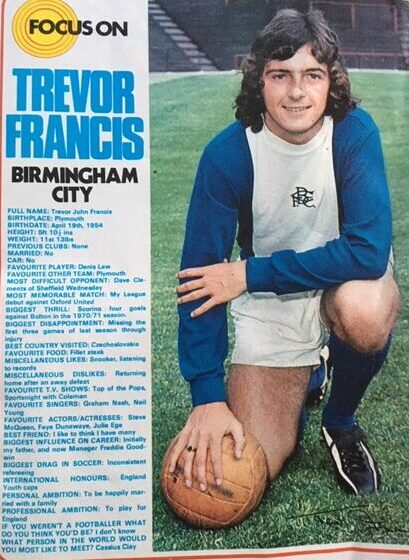
The responses rarely fluctuated. What Person in the World Would You Most Like To Meet? Invariably Cassius Clay or latterly Muhammed Ali, Biggest Drag in Soccer (Who ever called it ‘soccer’?): Losing or returning from away matches having lost, Favourite Food: Steak (ALWAYS steak although some gastronomes threw in a few chips), Favourite Drink: The occasional lager, Favourite TV Shows: Sports programmes. If you Weren’t A Footballer What Would You Be?: No idea (Few even had the wit to say ‘Unemployed’). These answers were regular and often. Why young kids idolised these guys is anybody’s guess but it was a more innocent time. Perversely though, it was my favourite part of the magazine.
Responses to Favourite Singers and Favourite Actors were similarly goal-line narrow in scope. Players chose from a limited group and were always strictly MOR. They rarely strayed from the calm, unchallenging waters of Frank Sinatra, Dean Martin, Shirley Bassey, Sammy Davis Junior, Andy Williams and Dionne Warwick. The idea of Ralph Coates suggesting The Velvet Underground or Ian Ure professing his love for The Electric Prunes was just unthinkable.
Favourite Actors were similarly constricted. John Wayne and Steve McQueen, naturally, Paul Newman, Barbra Streisand and, inevitably, Raquel Welsh (who once in the 70s attended a Chelsea match with Jimmy Hill. I have it on good authority, though, they were not romantically linked).
Of course, there were occasional exceptions to the rule. Malcolm Allison, for example, in 1972 stated the The Person In The World He Would Most Like To Meet was Enoch Powell M.P. and his Best Country Visited was South Africa. Well fancy that! Curiously, his Miscellaneous Dislike was ‘Narrow-minded people.’ And he also took the opportunity when asked what his Personal Ambition was to shamelessly promote his new game ‘Spot-On-Soccer’. He hoped it would become a ‘classic game.’ Can’t win them all Malcolm. In fact, you didn’t win that many as a manager either. Even odder was the job he’d have done if not a footballer manager: a psychiatrist. Some years ago I was changing trains at York Station and as I was leaving the train Malcolm Allison was getting on. In his hand was a glass which contained an extremely large measure of whisky. Once a 70s footballer manager….
Other exceptions to the hard and fast rules of ‘Focus on…’ were Franz Beckenbauer who, enigmatically for Der Kaiser, wanted to meet Mao Tse Tung, Chris Cattlin of Coventry City’s favourite singer was Harry Secombe (what?!), Brian Hall of Liverpool’s favourite food was liver, kidneys and carrots (revolting), while Leicester midfielder Alan Birchenall was on the horns of a dilemma and couldn’t decide whether he’d prefer to meet Adolf Hitler or Neil Diamond. I feel your pain, Alan.
These were also the days of ‘free gifts’ with comics and magazines, little incentives to kids to buy a particular publication and Shoot shamelessly, and thrillingly for the sporty adolescent boy (i.e. me), issued a range of football-based statistical tools throughout the calendar year. Its most celebrated enticement, issued every August for many years, was the full-colour league ladder! Printed on cardboard on which all four English and both Scottish leagues were included. Little tabs representing every English and Scottish club could be detached and slotted into the league ladder every week to account for changes in each team’s position. In truth, few readers could be bothered messing about with them after about half a dozen games of a new season but they were initially exciting. They represented the start of a spanking new football season after the longeurs of the summer months, particularly when there was no World Cup that year. It also allowed you to mess about with league positions and see what it would look like if your team was implausibly at the top and the teams you hated were at the bottom. In short, the ladders allowed us to dream. For a few weeks at least. Then in January Shoot would release their full-colour English FA and Scottish cup wall charts, where teams’ progress could be plotted from round three to the final in May. Again by the Fourth Round filling in the little boxes with a felt pen began to get a slightly tedious but what the hell, it looked good on the wall of your bedroom. In the days of instant statistics at the push of a few buttons, such fripperies seem rather quaint and maybe even slightly opportunistic on the part of the magazines, but they were different and I wish I still had them today.
Shoot magazine also tried to draw in its young readers by featuring three very well known columnists throughout the 70s. To describe the three players involved as ‘columnists’ was maybe going a bit far as they almost certainly only had a short telephone conversation with a ghost writer each week, but their ‘columns’ were masterpieces of pointless creativity, tedium and repetition.
A Shoot fixture throughout the late 60s and 70s was Bobby Moore, World Cup winning England captain (as they never stopped reminding you) and all-round decent chap. His weekly thoughts circumnavigated the English game from A to B and there was no dull and dusty corner of Upton Park which wasn’t explored, analysed and left out to dry. Every single week. Occasionally he (or his increasingly desperate ghost writer) tried to spice things up by chucking in a bit of non-football minutiae. His column of 21st July 1973, for example, began, ‘Here I am lazing away the hours with my wife Tina, and children Roberta and Dean in Marbella, Spain.’ Well, where else would a 70s footballer and his lovely ex-model wife be during the close season? So far so predictable. Writing a weekly column at that time of year must have been far from easy.
Or was it? Step forward columnist number 2, Mr. Alan Ball, or ‘Soccer As I See It by Alan Ball’ to give the column its official title. This, invariably, was just a rehash of what Bobby Moore was talking about essentially but, in Ball’s case, about Arsenal. If anything Alan Ball included a bit more about his glamorous private life. The films he’d been to see, restaurants he’d eaten at and at this time of the close season, where he was on holiday, and yes, you’ve guessed it, it’s Majorca! With, obviously, his lovely ex-model wife Lesley and daughter Keely.
Third on the bill was the one and only George Best whose wayward life eventually led to him being replaced with the more child-friendly and dependable, but just as lugubrious, Kevin Keegan. The alliteratively titled ‘Keep Up With Kevin Keegan’ continued to carry the torch of tedium after Georgie’s heavily bowdlerised column was given a free transfer.
It was a clever ploy by Shoot to feature these players at a time when football still had an air of mystery and excitement to it. The occasional tantalising glimpses on Saturday night football highlights programmes, Sam Leitch’s Football Preview or ‘Sportsnight with Coleman’ was about all anyone saw of these, and other, stars. Regular live football on TV was a long, long way off and it was the novelty of only occasionally seeing them play that elevated them to such heights of wonderment. And we continued to put up with the humdrum nature of their lives which, at the time, seemed impossibly glamorous. Shoot was shining light into magic. They were our friends, they were talking to us. An idea celebrity magazines tapped into many years later.

But Shoot was not alone in welcoming us into the lovely homes of our footballing idols. ‘Goal’ also did its bit but for slightly more mature readers. Goal was less colourful and more wordy, even including regular league tables and a pools guide for the older fan without a bird.
In the early 70s Goal included a short-lived celeb footballer column and featured ‘Bobby Charlton’s Diary.’ Short-lived? Not short enough as it was a column of such mind-numbing dullness that the classified ads at the back of the magazine gave the reader a comparative frisson of excitement. The opening sentence to his September 1968 column was ‘The World Cup is still nearly two years away so there is a lot that can happen between now and then.’ You losing your column for a start, Bob. And it went downhill from there. Goal, therefore, eschewed the need for football celebrity columns and, it’s true, colour posters were sparse but what they did have every week was ‘The Girl Behind The Man’! A feature of such breathtaking 70s crassness it could take its place with Dick Emery, The Wheeltappers and Shunters’ Social Club and Old-English Spangles as an iconic 70s product.
The feature spoke for itself. After a long hard day of training, drinking and fagging it, where does this Third Division footballing demi-god go when it’s closing time at the Coach and Horses (pubs did shut at 10.00pm don’t forget)? Back to the little lady, of course. And those ‘’Girls Behind The Man’ were only too happy to open up their gorgeous suburban semis to the Goal photographer. A regular ingredient of the photo-shoot was the bikini shot. One could imagine the slightly sleazy, unctuously Brylcreemed photographer suggesting, ‘Do you have a bikini, love?’ Usually the girl behind the man was only too happy to recline on her vast suburban lawn as a February wind blew icily around her. Let’s face it, we were told they were all ex-models anyway. Take the lovely Beryl Harris (28 September 1968), lovely ex-model wife of Cardiff City striker, Brian Harris, for example. Beryl’s hobbies are sunbathing and gardening, and here’s a gorgeous shot of Beryl doing some gardening in her bikini to kill two birds with one wide-angled stone.
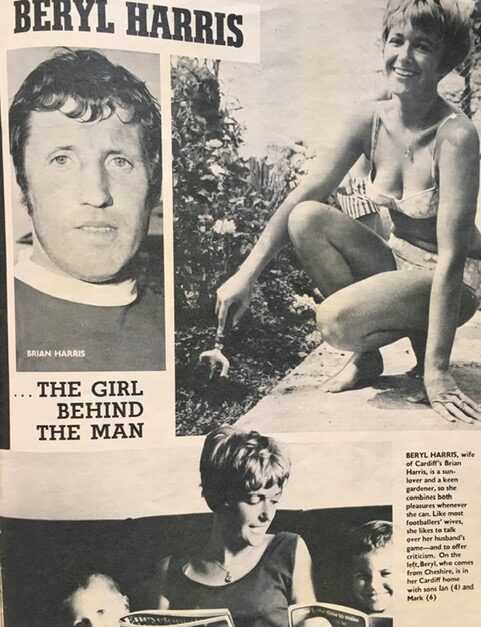
Not all wives were quite so willing though. Here’s Peter Cormack’s wife Marion who particularly enjoys swimming, dancing, driving and playing records and she is usefully photographed spinning some discs on her state-of-the -art radiogram. As Marion appeared in the January 30th 1971 edition of Goal, a bikini shot must have been out of the question, even for an ex-model.
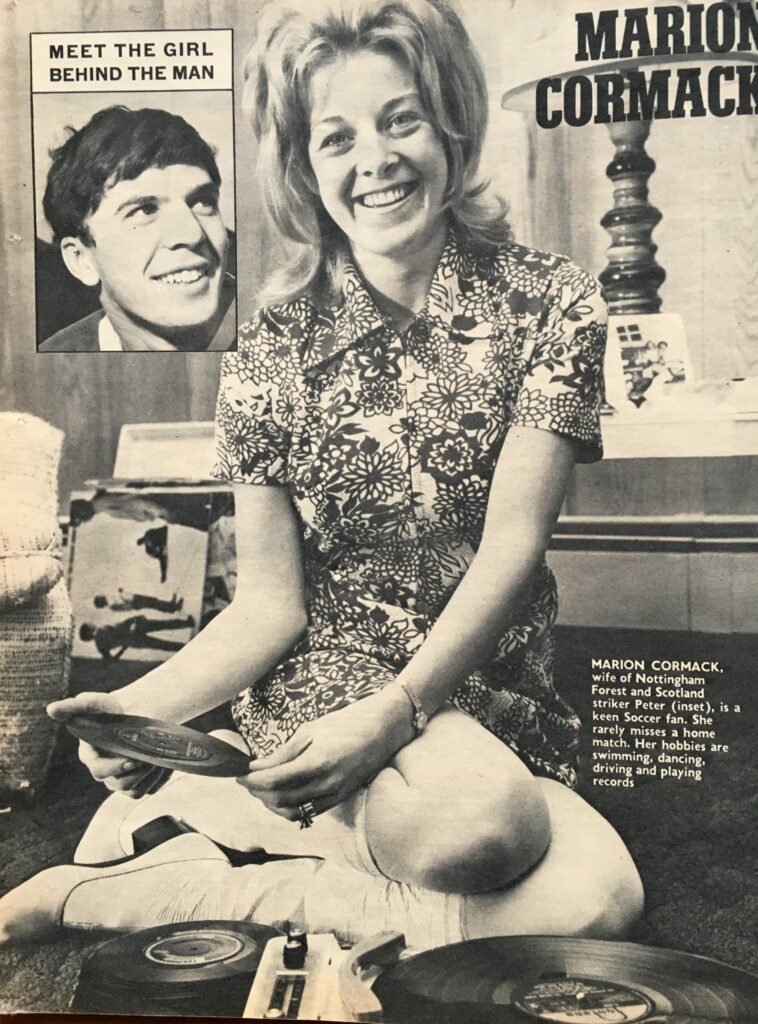
Shoot and Goal magazines eventually merged in 1974 as a number of other less worthy but more colourful football magazines became available but this flag of convenience wasn’t to last. Shoot continued until 2008, latterly as a monthly edition but football, and technology, had changed. Top class football was more clinical, scientific, distant and less characterful. Young people were less interested in the individuals and more focussed on the team, or more accurately, the brand. Would any modern player be interested in a weekly, or even monthly ghost-written column nowadays? It’s not as if they need the money and despite Bally and Moore-O’s efforts at trying to make their lives seem endlessly glamorous, they can’t really compete with today’s stars’ lives. And would they want to? Details of how they tweaked their nutritional regime, bought a new Aston Martin/ private plane/ Rolex watch or signed a new image rights’ contract, despite their lives being truly glittering, just doesn’t quite cut the mustard. Today’s top players are bland, untouchable and so removed in every way from the fans, that Shoot and Goal just seem like quaint anachronisms, evoking a time when fans still felt part of the game. Now they they are expected to feel privileged to be allowed to watch it, at a price obviously.
With billions of pounds swilling around in the game, players coming from all over the world for short but expensive stints with certain teams before , expensively, moving on, every football league in the world available, at a price, to be watched 24/7 and rolling TV news and statistics at a touch of a button, the world of teenage football magazines seems like a different age. But I think I preferred it when my football idols went on holiday to Marbella, and were only too happy to share this rather mundane information with us.
Now, what did I do with those league ladders?
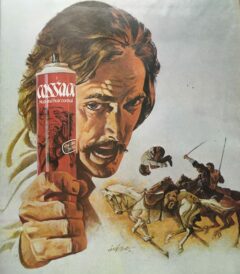
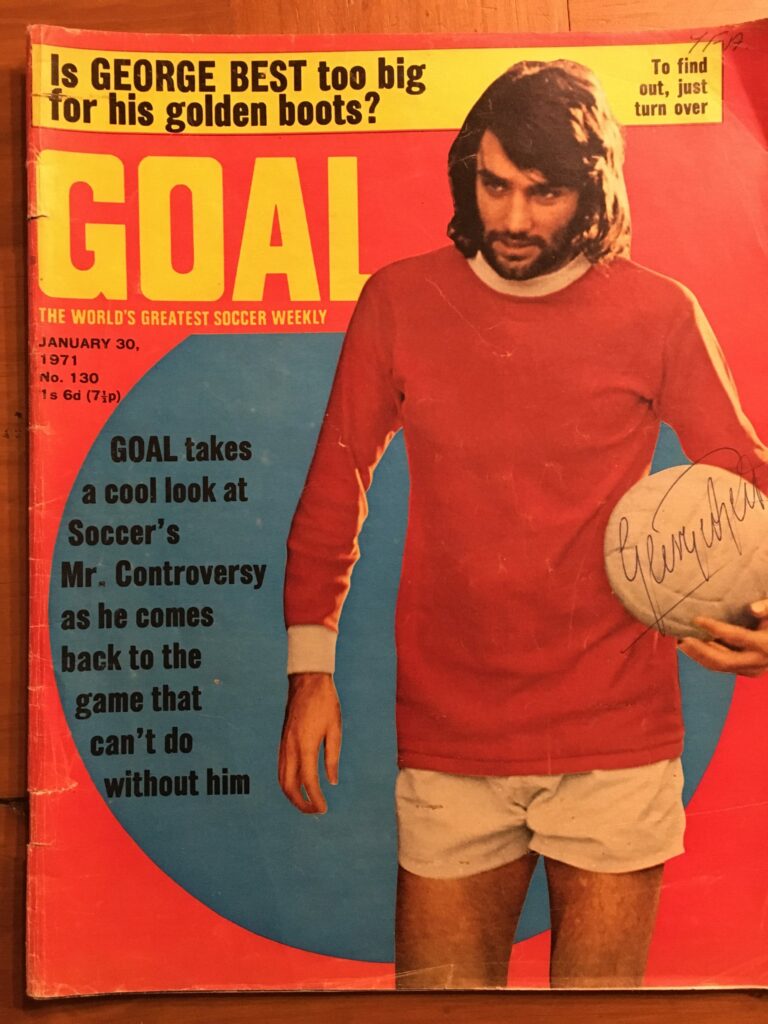
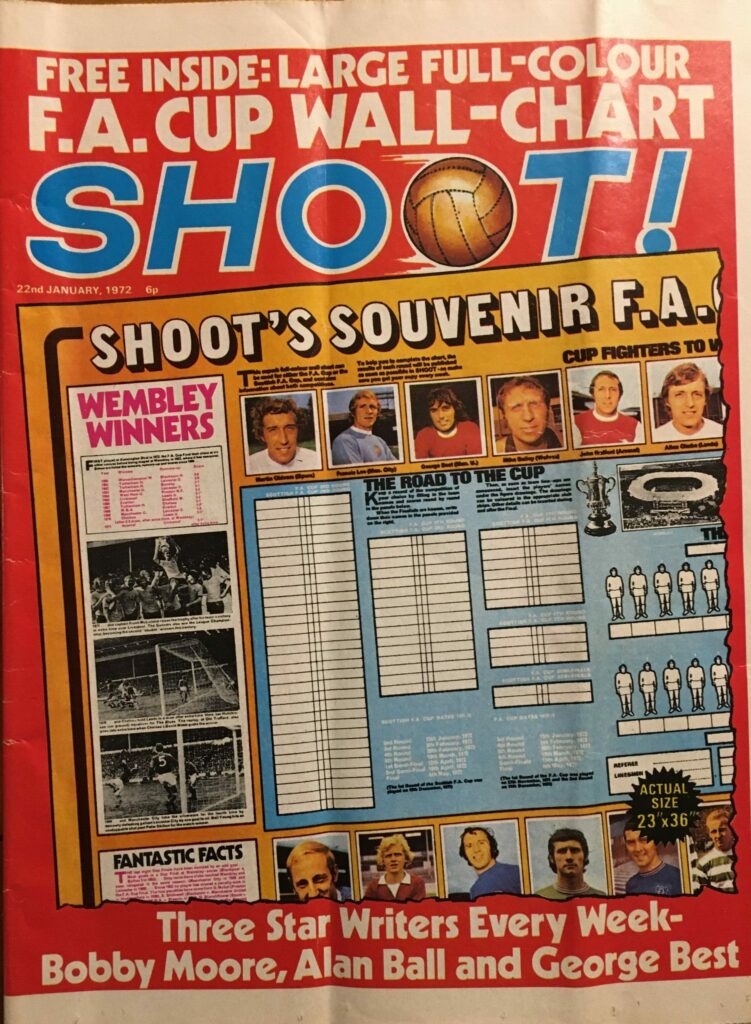
[…] Shoot and Goal Magazine: When Football Was Football and Not Just A ‘Product’ […]